Article Critique: IPV, Neighborhood Violence, and Mental Health
VerifiedAdded on 2023/06/05
|12
|3478
|191
Report
AI Summary
This assignment is an article critique of a research study investigating the association between intimate partner violence (IPV), neighborhood violence, and mental health outcomes in pregnant women residing in New Orleans. The study, conducted between 2010 and 2012, examined 398 women using surveys and interviews to assess their exposure to violence and assess mental health outcomes such as depression, pregnancy-specific anxiety, and PTSD. The critique analyzes the study's methods, including data collection, exposure and outcome assessments, and statistical analysis. The results indicated a significant relationship between IPV and probable depression and PTSD, as well as between neighborhood crime and mental health. The critique further evaluates the study's strengths, such as its clear statement of purpose and detailed methodology, while also pointing out limitations like the relatively small sample size and potential biases in sampling. The discussion section links the findings to existing literature and highlights the importance of the study in providing further evidence on the topic.
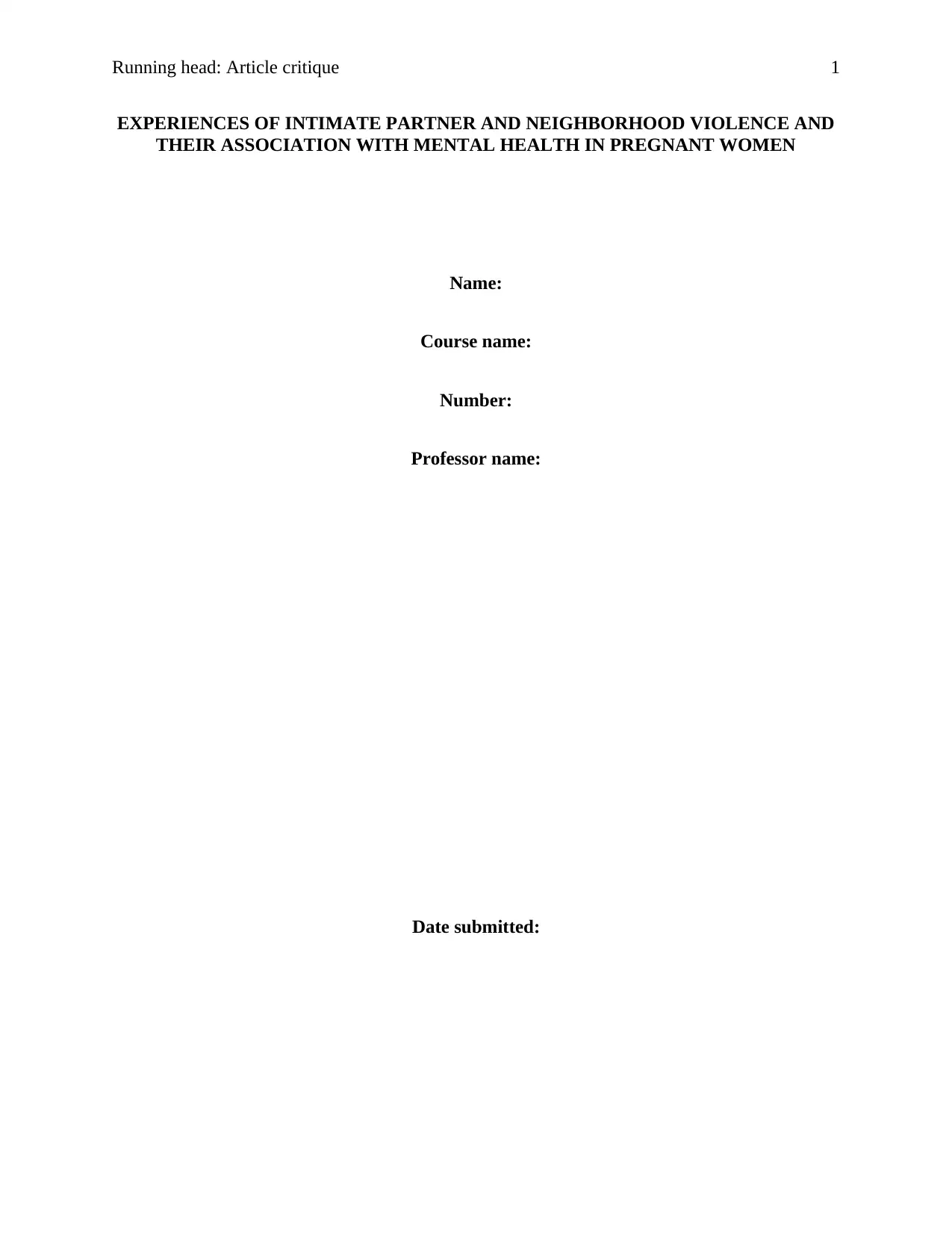
Running head: Article critique 1
EXPERIENCES OF INTIMATE PARTNER AND NEIGHBORHOOD VIOLENCE AND
THEIR ASSOCIATION WITH MENTAL HEALTH IN PREGNANT WOMEN
Name:
Course name:
Number:
Professor name:
Date submitted:
EXPERIENCES OF INTIMATE PARTNER AND NEIGHBORHOOD VIOLENCE AND
THEIR ASSOCIATION WITH MENTAL HEALTH IN PREGNANT WOMEN
Name:
Course name:
Number:
Professor name:
Date submitted:
Paraphrase This Document
Need a fresh take? Get an instant paraphrase of this document with our AI Paraphraser
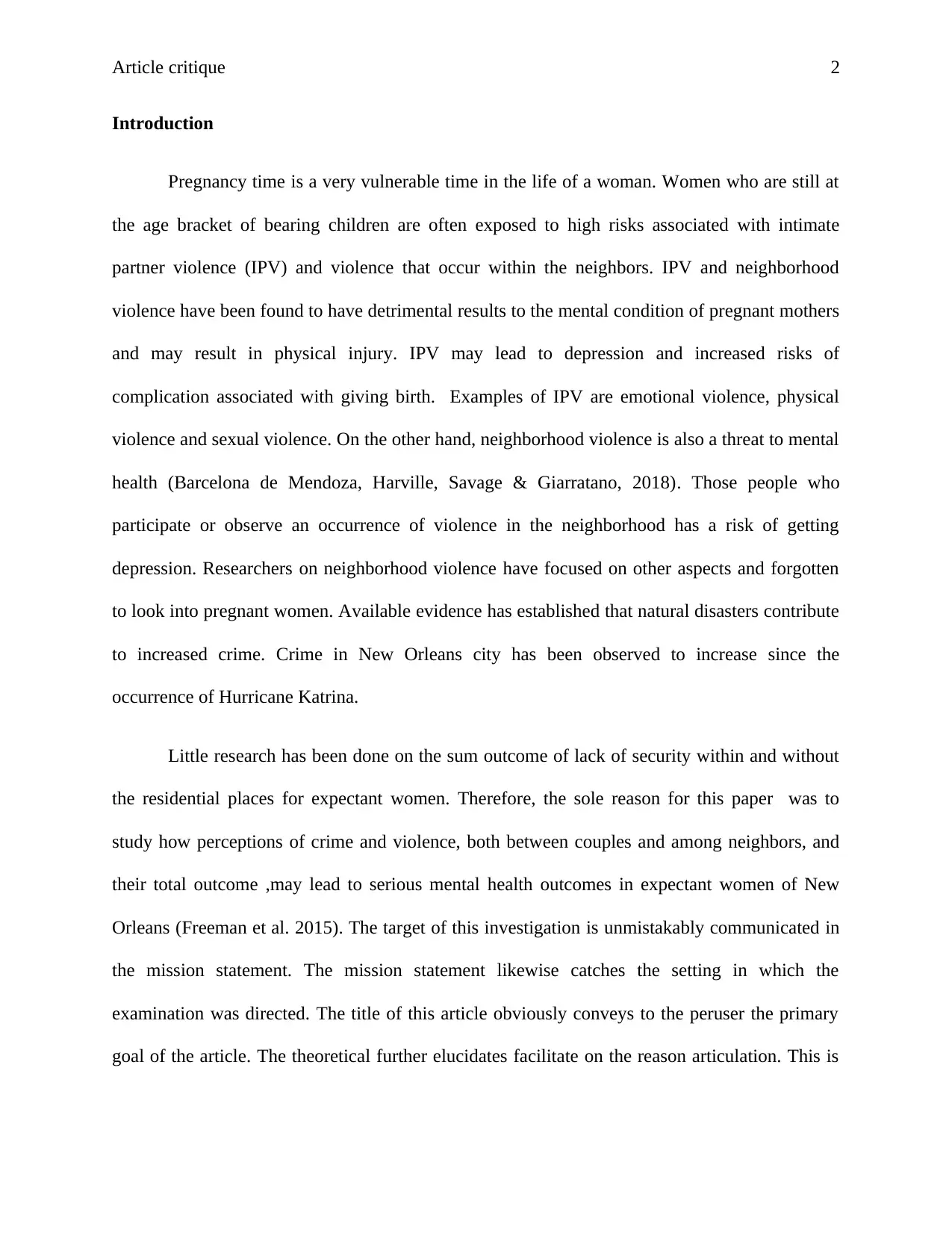
Article critique 2
Introduction
Pregnancy time is a very vulnerable time in the life of a woman. Women who are still at
the age bracket of bearing children are often exposed to high risks associated with intimate
partner violence (IPV) and violence that occur within the neighbors. IPV and neighborhood
violence have been found to have detrimental results to the mental condition of pregnant mothers
and may result in physical injury. IPV may lead to depression and increased risks of
complication associated with giving birth. Examples of IPV are emotional violence, physical
violence and sexual violence. On the other hand, neighborhood violence is also a threat to mental
health (Barcelona de Mendoza, Harville, Savage & Giarratano, 2018). Those people who
participate or observe an occurrence of violence in the neighborhood has a risk of getting
depression. Researchers on neighborhood violence have focused on other aspects and forgotten
to look into pregnant women. Available evidence has established that natural disasters contribute
to increased crime. Crime in New Orleans city has been observed to increase since the
occurrence of Hurricane Katrina.
Little research has been done on the sum outcome of lack of security within and without
the residential places for expectant women. Therefore, the sole reason for this paper was to
study how perceptions of crime and violence, both between couples and among neighbors, and
their total outcome ,may lead to serious mental health outcomes in expectant women of New
Orleans (Freeman et al. 2015). The target of this investigation is unmistakably communicated in
the mission statement. The mission statement likewise catches the setting in which the
examination was directed. The title of this article obviously conveys to the peruser the primary
goal of the article. The theoretical further elucidates facilitate on the reason articulation. This is
Introduction
Pregnancy time is a very vulnerable time in the life of a woman. Women who are still at
the age bracket of bearing children are often exposed to high risks associated with intimate
partner violence (IPV) and violence that occur within the neighbors. IPV and neighborhood
violence have been found to have detrimental results to the mental condition of pregnant mothers
and may result in physical injury. IPV may lead to depression and increased risks of
complication associated with giving birth. Examples of IPV are emotional violence, physical
violence and sexual violence. On the other hand, neighborhood violence is also a threat to mental
health (Barcelona de Mendoza, Harville, Savage & Giarratano, 2018). Those people who
participate or observe an occurrence of violence in the neighborhood has a risk of getting
depression. Researchers on neighborhood violence have focused on other aspects and forgotten
to look into pregnant women. Available evidence has established that natural disasters contribute
to increased crime. Crime in New Orleans city has been observed to increase since the
occurrence of Hurricane Katrina.
Little research has been done on the sum outcome of lack of security within and without
the residential places for expectant women. Therefore, the sole reason for this paper was to
study how perceptions of crime and violence, both between couples and among neighbors, and
their total outcome ,may lead to serious mental health outcomes in expectant women of New
Orleans (Freeman et al. 2015). The target of this investigation is unmistakably communicated in
the mission statement. The mission statement likewise catches the setting in which the
examination was directed. The title of this article obviously conveys to the peruser the primary
goal of the article. The theoretical further elucidates facilitate on the reason articulation. This is
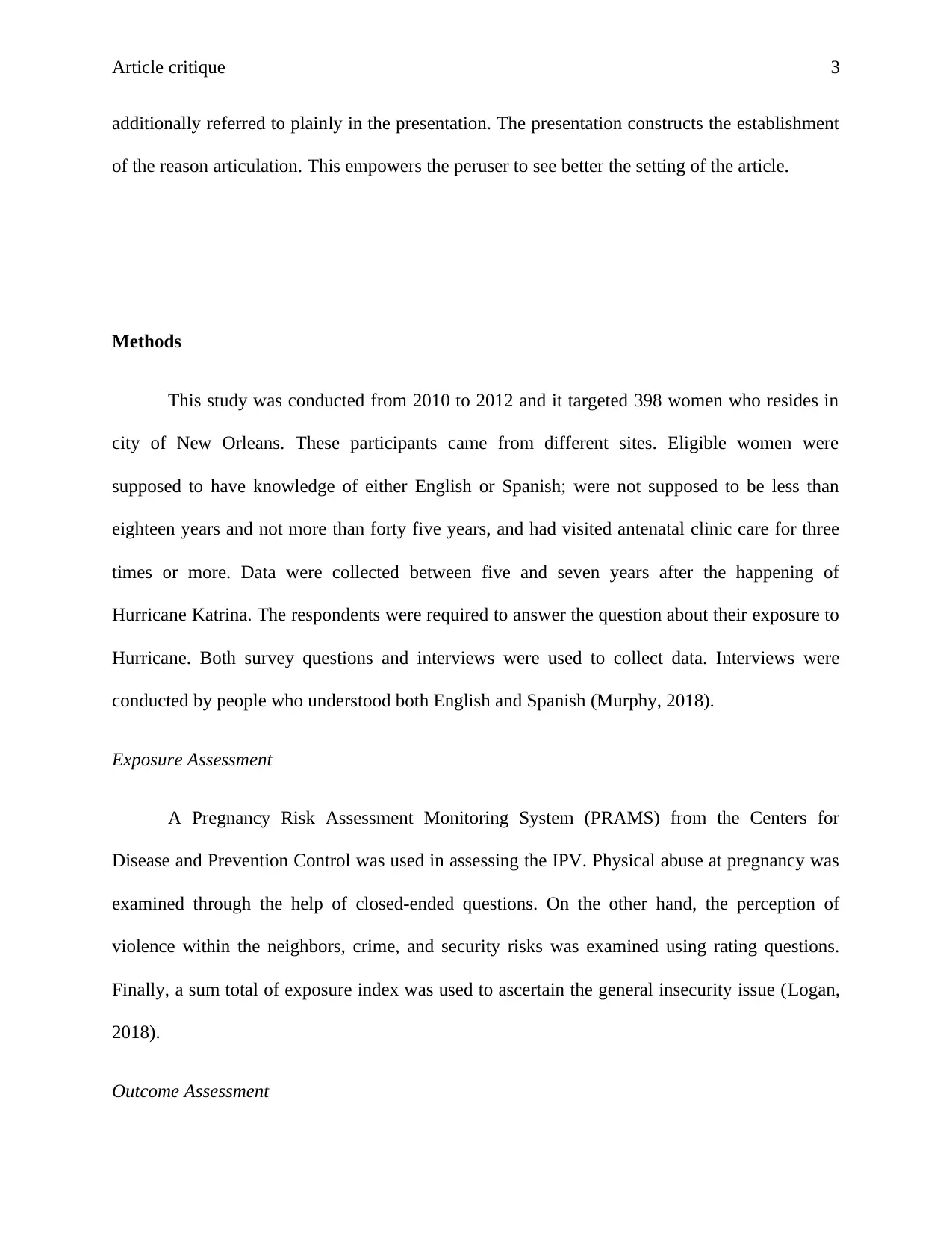
Article critique 3
additionally referred to plainly in the presentation. The presentation constructs the establishment
of the reason articulation. This empowers the peruser to see better the setting of the article.
Methods
This study was conducted from 2010 to 2012 and it targeted 398 women who resides in
city of New Orleans. These participants came from different sites. Eligible women were
supposed to have knowledge of either English or Spanish; were not supposed to be less than
eighteen years and not more than forty five years, and had visited antenatal clinic care for three
times or more. Data were collected between five and seven years after the happening of
Hurricane Katrina. The respondents were required to answer the question about their exposure to
Hurricane. Both survey questions and interviews were used to collect data. Interviews were
conducted by people who understood both English and Spanish (Murphy, 2018).
Exposure Assessment
A Pregnancy Risk Assessment Monitoring System (PRAMS) from the Centers for
Disease and Prevention Control was used in assessing the IPV. Physical abuse at pregnancy was
examined through the help of closed-ended questions. On the other hand, the perception of
violence within the neighbors, crime, and security risks was examined using rating questions.
Finally, a sum total of exposure index was used to ascertain the general insecurity issue (Logan,
2018).
Outcome Assessment
additionally referred to plainly in the presentation. The presentation constructs the establishment
of the reason articulation. This empowers the peruser to see better the setting of the article.
Methods
This study was conducted from 2010 to 2012 and it targeted 398 women who resides in
city of New Orleans. These participants came from different sites. Eligible women were
supposed to have knowledge of either English or Spanish; were not supposed to be less than
eighteen years and not more than forty five years, and had visited antenatal clinic care for three
times or more. Data were collected between five and seven years after the happening of
Hurricane Katrina. The respondents were required to answer the question about their exposure to
Hurricane. Both survey questions and interviews were used to collect data. Interviews were
conducted by people who understood both English and Spanish (Murphy, 2018).
Exposure Assessment
A Pregnancy Risk Assessment Monitoring System (PRAMS) from the Centers for
Disease and Prevention Control was used in assessing the IPV. Physical abuse at pregnancy was
examined through the help of closed-ended questions. On the other hand, the perception of
violence within the neighbors, crime, and security risks was examined using rating questions.
Finally, a sum total of exposure index was used to ascertain the general insecurity issue (Logan,
2018).
Outcome Assessment
⊘ This is a preview!⊘
Do you want full access?
Subscribe today to unlock all pages.

Trusted by 1+ million students worldwide
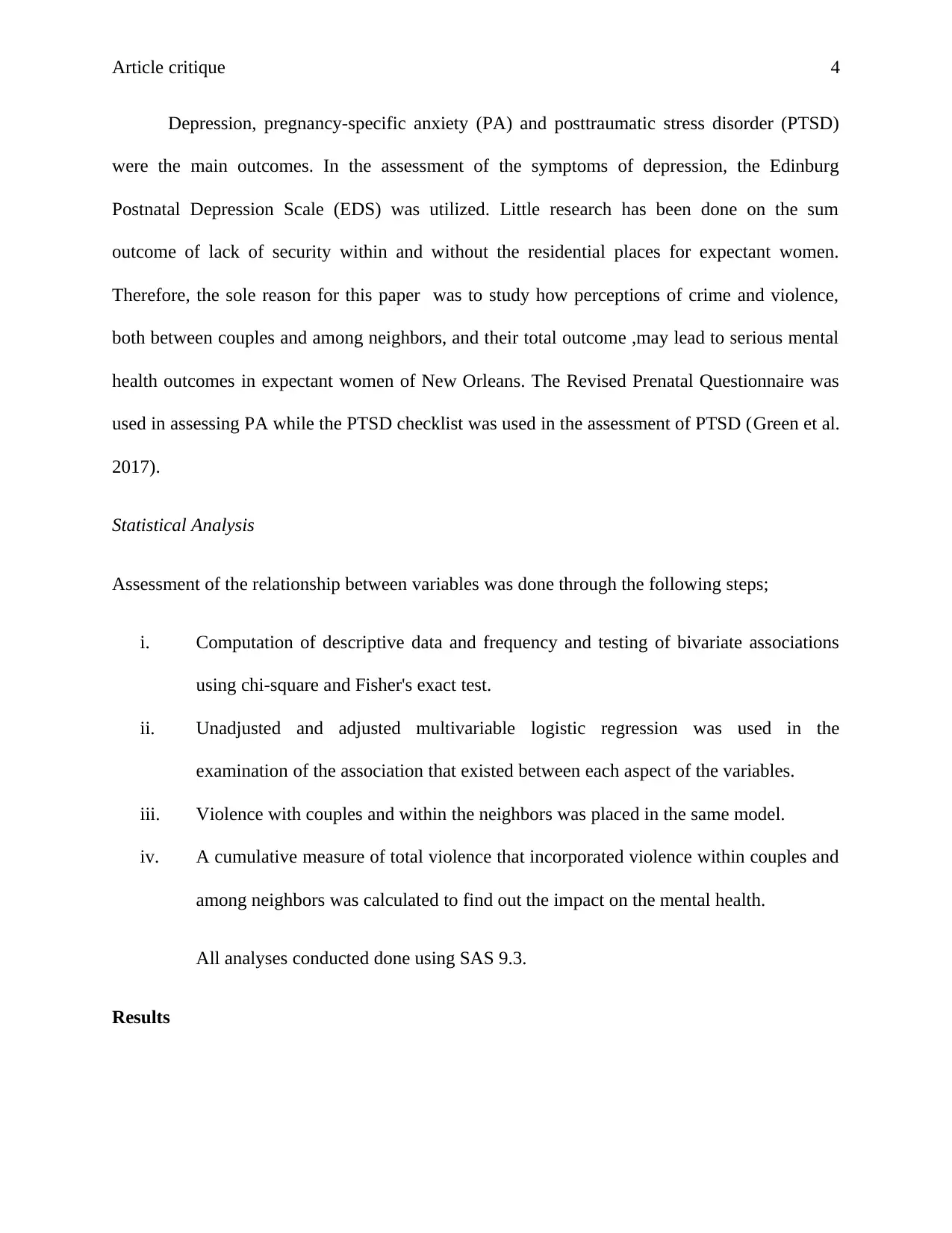
Article critique 4
Depression, pregnancy-specific anxiety (PA) and posttraumatic stress disorder (PTSD)
were the main outcomes. In the assessment of the symptoms of depression, the Edinburg
Postnatal Depression Scale (EDS) was utilized. Little research has been done on the sum
outcome of lack of security within and without the residential places for expectant women.
Therefore, the sole reason for this paper was to study how perceptions of crime and violence,
both between couples and among neighbors, and their total outcome ,may lead to serious mental
health outcomes in expectant women of New Orleans. The Revised Prenatal Questionnaire was
used in assessing PA while the PTSD checklist was used in the assessment of PTSD (Green et al.
2017).
Statistical Analysis
Assessment of the relationship between variables was done through the following steps;
i. Computation of descriptive data and frequency and testing of bivariate associations
using chi-square and Fisher's exact test.
ii. Unadjusted and adjusted multivariable logistic regression was used in the
examination of the association that existed between each aspect of the variables.
iii. Violence with couples and within the neighbors was placed in the same model.
iv. A cumulative measure of total violence that incorporated violence within couples and
among neighbors was calculated to find out the impact on the mental health.
All analyses conducted done using SAS 9.3.
Results
Depression, pregnancy-specific anxiety (PA) and posttraumatic stress disorder (PTSD)
were the main outcomes. In the assessment of the symptoms of depression, the Edinburg
Postnatal Depression Scale (EDS) was utilized. Little research has been done on the sum
outcome of lack of security within and without the residential places for expectant women.
Therefore, the sole reason for this paper was to study how perceptions of crime and violence,
both between couples and among neighbors, and their total outcome ,may lead to serious mental
health outcomes in expectant women of New Orleans. The Revised Prenatal Questionnaire was
used in assessing PA while the PTSD checklist was used in the assessment of PTSD (Green et al.
2017).
Statistical Analysis
Assessment of the relationship between variables was done through the following steps;
i. Computation of descriptive data and frequency and testing of bivariate associations
using chi-square and Fisher's exact test.
ii. Unadjusted and adjusted multivariable logistic regression was used in the
examination of the association that existed between each aspect of the variables.
iii. Violence with couples and within the neighbors was placed in the same model.
iv. A cumulative measure of total violence that incorporated violence within couples and
among neighbors was calculated to find out the impact on the mental health.
All analyses conducted done using SAS 9.3.
Results
Paraphrase This Document
Need a fresh take? Get an instant paraphrase of this document with our AI Paraphraser
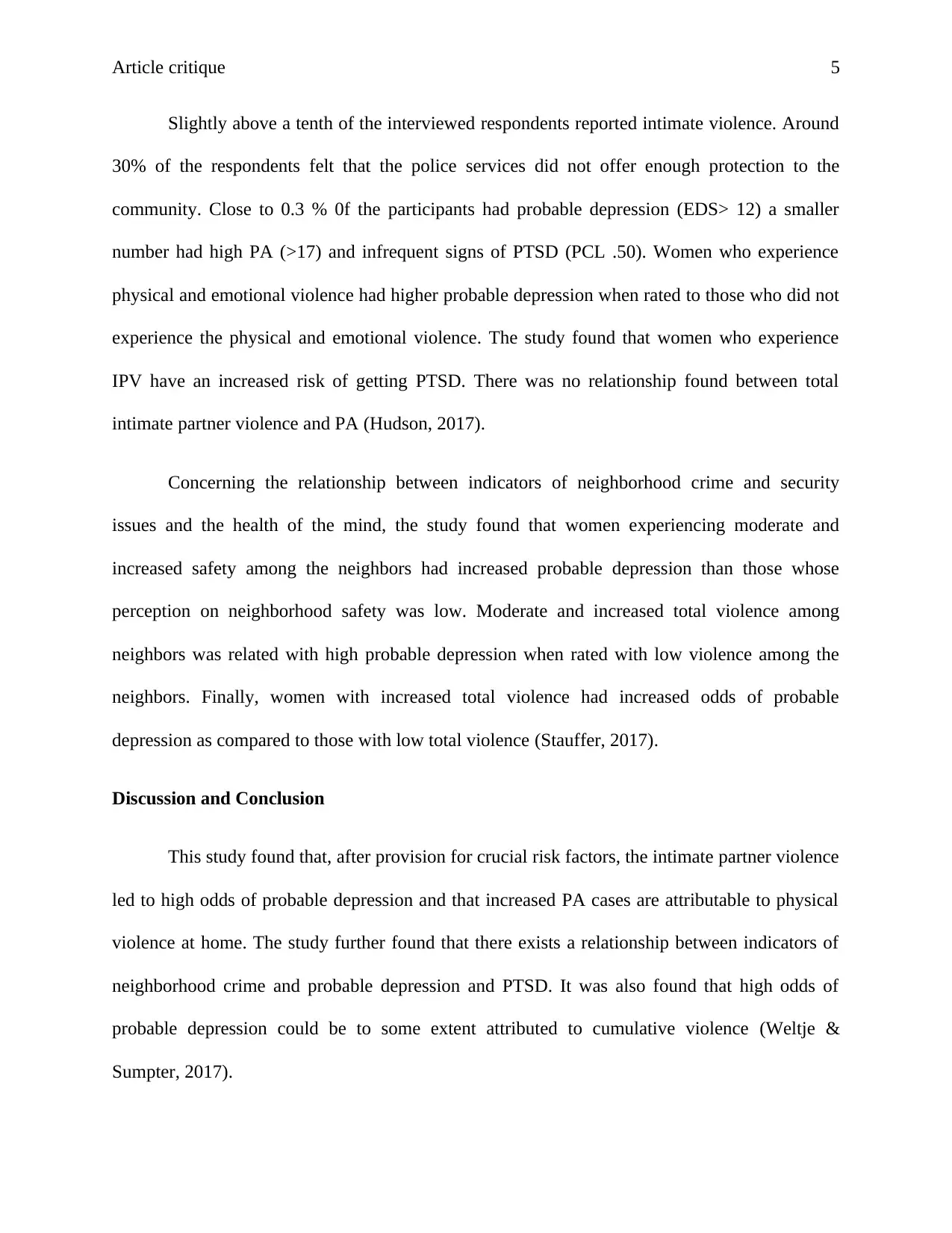
Article critique 5
Slightly above a tenth of the interviewed respondents reported intimate violence. Around
30% of the respondents felt that the police services did not offer enough protection to the
community. Close to 0.3 % 0f the participants had probable depression (EDS> 12) a smaller
number had high PA (>17) and infrequent signs of PTSD (PCL .50). Women who experience
physical and emotional violence had higher probable depression when rated to those who did not
experience the physical and emotional violence. The study found that women who experience
IPV have an increased risk of getting PTSD. There was no relationship found between total
intimate partner violence and PA (Hudson, 2017).
Concerning the relationship between indicators of neighborhood crime and security
issues and the health of the mind, the study found that women experiencing moderate and
increased safety among the neighbors had increased probable depression than those whose
perception on neighborhood safety was low. Moderate and increased total violence among
neighbors was related with high probable depression when rated with low violence among the
neighbors. Finally, women with increased total violence had increased odds of probable
depression as compared to those with low total violence (Stauffer, 2017).
Discussion and Conclusion
This study found that, after provision for crucial risk factors, the intimate partner violence
led to high odds of probable depression and that increased PA cases are attributable to physical
violence at home. The study further found that there exists a relationship between indicators of
neighborhood crime and probable depression and PTSD. It was also found that high odds of
probable depression could be to some extent attributed to cumulative violence (Weltje &
Sumpter, 2017).
Slightly above a tenth of the interviewed respondents reported intimate violence. Around
30% of the respondents felt that the police services did not offer enough protection to the
community. Close to 0.3 % 0f the participants had probable depression (EDS> 12) a smaller
number had high PA (>17) and infrequent signs of PTSD (PCL .50). Women who experience
physical and emotional violence had higher probable depression when rated to those who did not
experience the physical and emotional violence. The study found that women who experience
IPV have an increased risk of getting PTSD. There was no relationship found between total
intimate partner violence and PA (Hudson, 2017).
Concerning the relationship between indicators of neighborhood crime and security
issues and the health of the mind, the study found that women experiencing moderate and
increased safety among the neighbors had increased probable depression than those whose
perception on neighborhood safety was low. Moderate and increased total violence among
neighbors was related with high probable depression when rated with low violence among the
neighbors. Finally, women with increased total violence had increased odds of probable
depression as compared to those with low total violence (Stauffer, 2017).
Discussion and Conclusion
This study found that, after provision for crucial risk factors, the intimate partner violence
led to high odds of probable depression and that increased PA cases are attributable to physical
violence at home. The study further found that there exists a relationship between indicators of
neighborhood crime and probable depression and PTSD. It was also found that high odds of
probable depression could be to some extent attributed to cumulative violence (Weltje &
Sumpter, 2017).

Article critique 6
Majority of the findings of this study were found to agree in with the results of previous
researchers on the same topic. In the question of the sum total impact of IPV and violence within
the neighbors on mental health, our outcomes agreed with two studies but differed with one. The
difference is attributed to the different perception of violence and crime by the participant
(Veblen, 2017).
This study is important as it provides more knowledge and evidence on the topic of study.
The sample used in this study was relatively small. Future researchers should consider studying
how different violence influence different aspects of life.
Critique of research
Statement of purpose
This research is designed to assess how perceptions of crime and violence, among
couples and within the neighbors and their total impact on the mental health mental among
expectant women in New Orleans. The objective of this study is clearly expressed in the
statement of purpose. The statement of purpose also captures the setting in which the research
was conducted. The title of this article clearly communicates to the reader the main objective of
the article. The abstract further expounds further on the purpose statement. This is further cited
clearly in the introduction. The introduction builds the foundation of the purpose statement. This
enables the reader to understand better the context of the article. The introduction previews
previous works and clearly illustrates the gap that this article is going to fill. The statement of
purpose also provides the variables of the research and the correlation between violence both
intimate and neighborhood affects mental health (Williams, 2018).
Method
Majority of the findings of this study were found to agree in with the results of previous
researchers on the same topic. In the question of the sum total impact of IPV and violence within
the neighbors on mental health, our outcomes agreed with two studies but differed with one. The
difference is attributed to the different perception of violence and crime by the participant
(Veblen, 2017).
This study is important as it provides more knowledge and evidence on the topic of study.
The sample used in this study was relatively small. Future researchers should consider studying
how different violence influence different aspects of life.
Critique of research
Statement of purpose
This research is designed to assess how perceptions of crime and violence, among
couples and within the neighbors and their total impact on the mental health mental among
expectant women in New Orleans. The objective of this study is clearly expressed in the
statement of purpose. The statement of purpose also captures the setting in which the research
was conducted. The title of this article clearly communicates to the reader the main objective of
the article. The abstract further expounds further on the purpose statement. This is further cited
clearly in the introduction. The introduction builds the foundation of the purpose statement. This
enables the reader to understand better the context of the article. The introduction previews
previous works and clearly illustrates the gap that this article is going to fill. The statement of
purpose also provides the variables of the research and the correlation between violence both
intimate and neighborhood affects mental health (Williams, 2018).
Method
⊘ This is a preview!⊘
Do you want full access?
Subscribe today to unlock all pages.

Trusted by 1+ million students worldwide
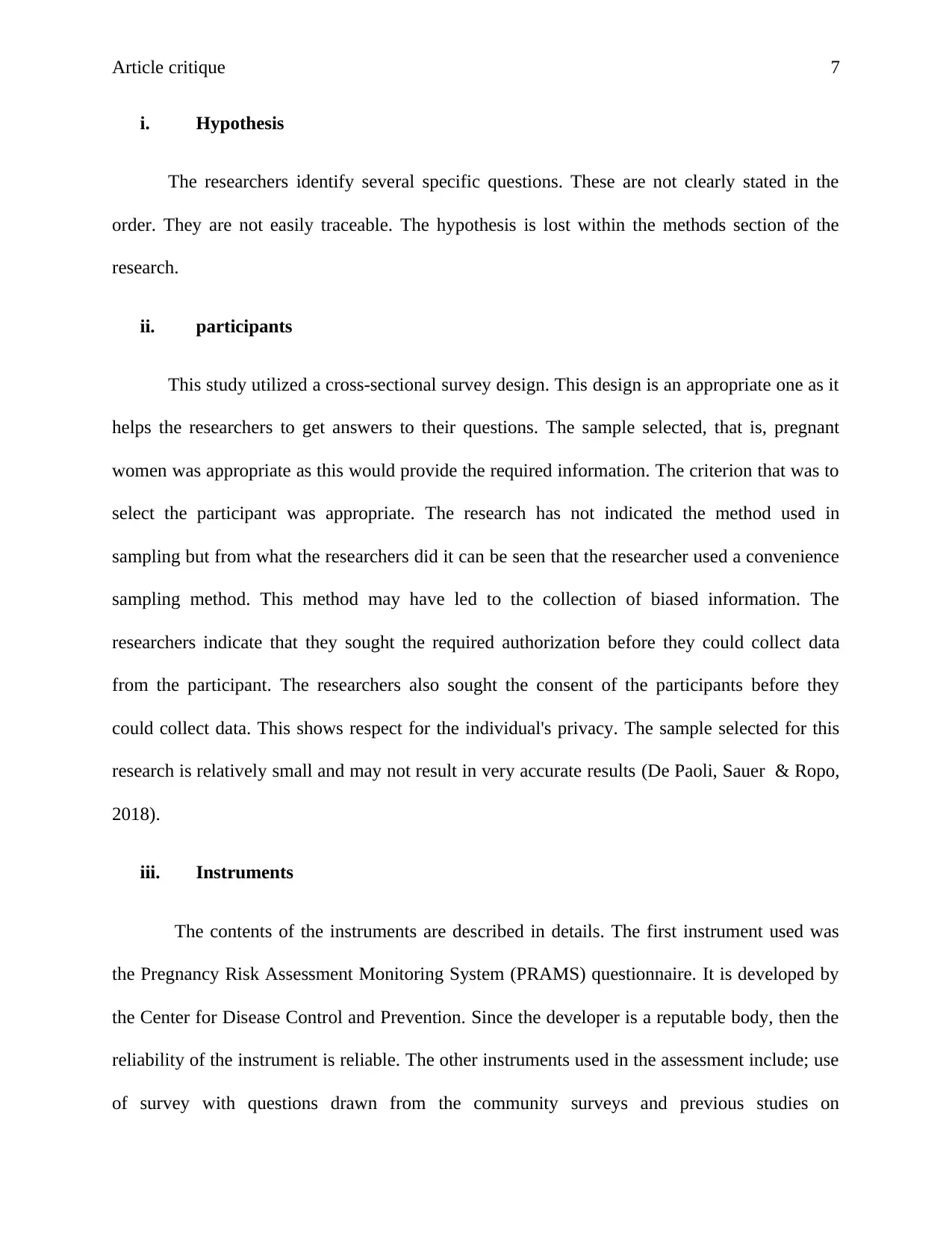
Article critique 7
i. Hypothesis
The researchers identify several specific questions. These are not clearly stated in the
order. They are not easily traceable. The hypothesis is lost within the methods section of the
research.
ii. participants
This study utilized a cross-sectional survey design. This design is an appropriate one as it
helps the researchers to get answers to their questions. The sample selected, that is, pregnant
women was appropriate as this would provide the required information. The criterion that was to
select the participant was appropriate. The research has not indicated the method used in
sampling but from what the researchers did it can be seen that the researcher used a convenience
sampling method. This method may have led to the collection of biased information. The
researchers indicate that they sought the required authorization before they could collect data
from the participant. The researchers also sought the consent of the participants before they
could collect data. This shows respect for the individual's privacy. The sample selected for this
research is relatively small and may not result in very accurate results (De Paoli, Sauer & Ropo,
2018).
iii. Instruments
The contents of the instruments are described in details. The first instrument used was
the Pregnancy Risk Assessment Monitoring System (PRAMS) questionnaire. It is developed by
the Center for Disease Control and Prevention. Since the developer is a reputable body, then the
reliability of the instrument is reliable. The other instruments used in the assessment include; use
of survey with questions drawn from the community surveys and previous studies on
i. Hypothesis
The researchers identify several specific questions. These are not clearly stated in the
order. They are not easily traceable. The hypothesis is lost within the methods section of the
research.
ii. participants
This study utilized a cross-sectional survey design. This design is an appropriate one as it
helps the researchers to get answers to their questions. The sample selected, that is, pregnant
women was appropriate as this would provide the required information. The criterion that was to
select the participant was appropriate. The research has not indicated the method used in
sampling but from what the researchers did it can be seen that the researcher used a convenience
sampling method. This method may have led to the collection of biased information. The
researchers indicate that they sought the required authorization before they could collect data
from the participant. The researchers also sought the consent of the participants before they
could collect data. This shows respect for the individual's privacy. The sample selected for this
research is relatively small and may not result in very accurate results (De Paoli, Sauer & Ropo,
2018).
iii. Instruments
The contents of the instruments are described in details. The first instrument used was
the Pregnancy Risk Assessment Monitoring System (PRAMS) questionnaire. It is developed by
the Center for Disease Control and Prevention. Since the developer is a reputable body, then the
reliability of the instrument is reliable. The other instruments used in the assessment include; use
of survey with questions drawn from the community surveys and previous studies on
Paraphrase This Document
Need a fresh take? Get an instant paraphrase of this document with our AI Paraphraser
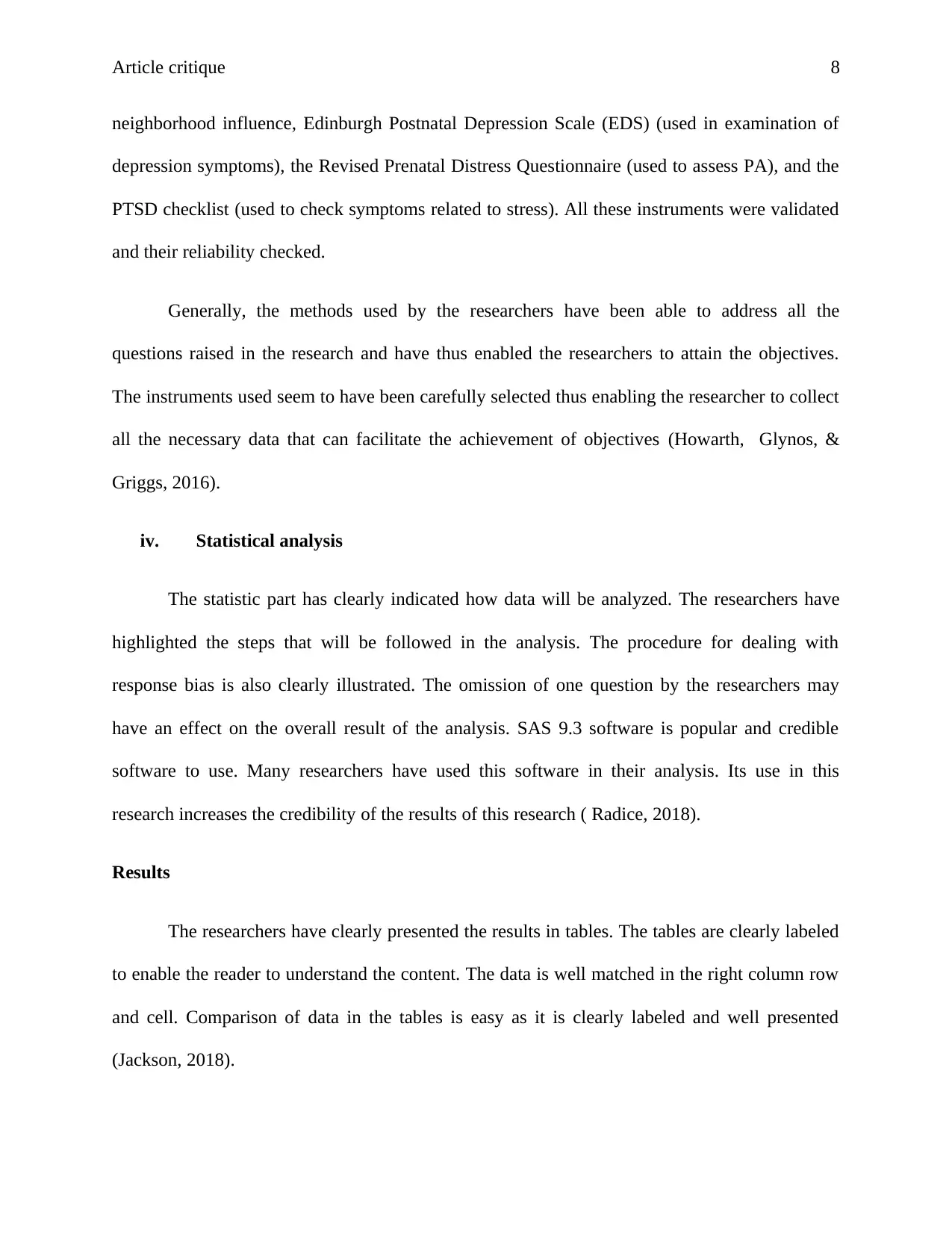
Article critique 8
neighborhood influence, Edinburgh Postnatal Depression Scale (EDS) (used in examination of
depression symptoms), the Revised Prenatal Distress Questionnaire (used to assess PA), and the
PTSD checklist (used to check symptoms related to stress). All these instruments were validated
and their reliability checked.
Generally, the methods used by the researchers have been able to address all the
questions raised in the research and have thus enabled the researchers to attain the objectives.
The instruments used seem to have been carefully selected thus enabling the researcher to collect
all the necessary data that can facilitate the achievement of objectives (Howarth, Glynos, &
Griggs, 2016).
iv. Statistical analysis
The statistic part has clearly indicated how data will be analyzed. The researchers have
highlighted the steps that will be followed in the analysis. The procedure for dealing with
response bias is also clearly illustrated. The omission of one question by the researchers may
have an effect on the overall result of the analysis. SAS 9.3 software is popular and credible
software to use. Many researchers have used this software in their analysis. Its use in this
research increases the credibility of the results of this research ( Radice, 2018).
Results
The researchers have clearly presented the results in tables. The tables are clearly labeled
to enable the reader to understand the content. The data is well matched in the right column row
and cell. Comparison of data in the tables is easy as it is clearly labeled and well presented
(Jackson, 2018).
neighborhood influence, Edinburgh Postnatal Depression Scale (EDS) (used in examination of
depression symptoms), the Revised Prenatal Distress Questionnaire (used to assess PA), and the
PTSD checklist (used to check symptoms related to stress). All these instruments were validated
and their reliability checked.
Generally, the methods used by the researchers have been able to address all the
questions raised in the research and have thus enabled the researchers to attain the objectives.
The instruments used seem to have been carefully selected thus enabling the researcher to collect
all the necessary data that can facilitate the achievement of objectives (Howarth, Glynos, &
Griggs, 2016).
iv. Statistical analysis
The statistic part has clearly indicated how data will be analyzed. The researchers have
highlighted the steps that will be followed in the analysis. The procedure for dealing with
response bias is also clearly illustrated. The omission of one question by the researchers may
have an effect on the overall result of the analysis. SAS 9.3 software is popular and credible
software to use. Many researchers have used this software in their analysis. Its use in this
research increases the credibility of the results of this research ( Radice, 2018).
Results
The researchers have clearly presented the results in tables. The tables are clearly labeled
to enable the reader to understand the content. The data is well matched in the right column row
and cell. Comparison of data in the tables is easy as it is clearly labeled and well presented
(Jackson, 2018).

Article critique 9
The data in the tables is well complemented by the information recorded in the narration.
Close scrutiny of both data in the table and narration signifies no difference. The accuracy of the
researchers in entering the data is high. However, there is missing information in the table which
makes the cumulative percentages not to add up to 100%. Concerning the percentage issue, the
researchers have indicated it clearly to the reader that there the cumulative addition may not add
up to100% due to information that may be missing (Boyle, 2016).
The results presented clearly addresses each research question. Every hypothesis was
tested. Generally, the results obtained answers all the questions and provide all the relevant
information required to draw up conclusion (Feldman, Odling-Smee, & Laland, 2017)
Discussion
The researchers have provided a detailed discussion based on the results obtained. The
researchers link their findings with the findings of other studies. From the discussion, it can be
observed that the findings of this research are consistent with the findings of other studies. This
is clear proof that the research was keenly conducted (Freeman, Kobziar, Rose & Cropper,
2017).
Conclusion
This research conclusively was able to achieve its objectives. The findings of this study
provide more evidence of the influence of violence at several stages and neighborhood disorders
on a person’s health and illness. Despite having achieved its objectives, this research was faced
its strengths and weaknesses. One of the strengths of this research is that it had a combined focus
on individual experiences of violence. Individuals who are victims of domestic violence provide
real information which presents their personal experiences and the effects that those experiences
The data in the tables is well complemented by the information recorded in the narration.
Close scrutiny of both data in the table and narration signifies no difference. The accuracy of the
researchers in entering the data is high. However, there is missing information in the table which
makes the cumulative percentages not to add up to 100%. Concerning the percentage issue, the
researchers have indicated it clearly to the reader that there the cumulative addition may not add
up to100% due to information that may be missing (Boyle, 2016).
The results presented clearly addresses each research question. Every hypothesis was
tested. Generally, the results obtained answers all the questions and provide all the relevant
information required to draw up conclusion (Feldman, Odling-Smee, & Laland, 2017)
Discussion
The researchers have provided a detailed discussion based on the results obtained. The
researchers link their findings with the findings of other studies. From the discussion, it can be
observed that the findings of this research are consistent with the findings of other studies. This
is clear proof that the research was keenly conducted (Freeman, Kobziar, Rose & Cropper,
2017).
Conclusion
This research conclusively was able to achieve its objectives. The findings of this study
provide more evidence of the influence of violence at several stages and neighborhood disorders
on a person’s health and illness. Despite having achieved its objectives, this research was faced
its strengths and weaknesses. One of the strengths of this research is that it had a combined focus
on individual experiences of violence. Individuals who are victims of domestic violence provide
real information which presents their personal experiences and the effects that those experiences
⊘ This is a preview!⊘
Do you want full access?
Subscribe today to unlock all pages.

Trusted by 1+ million students worldwide
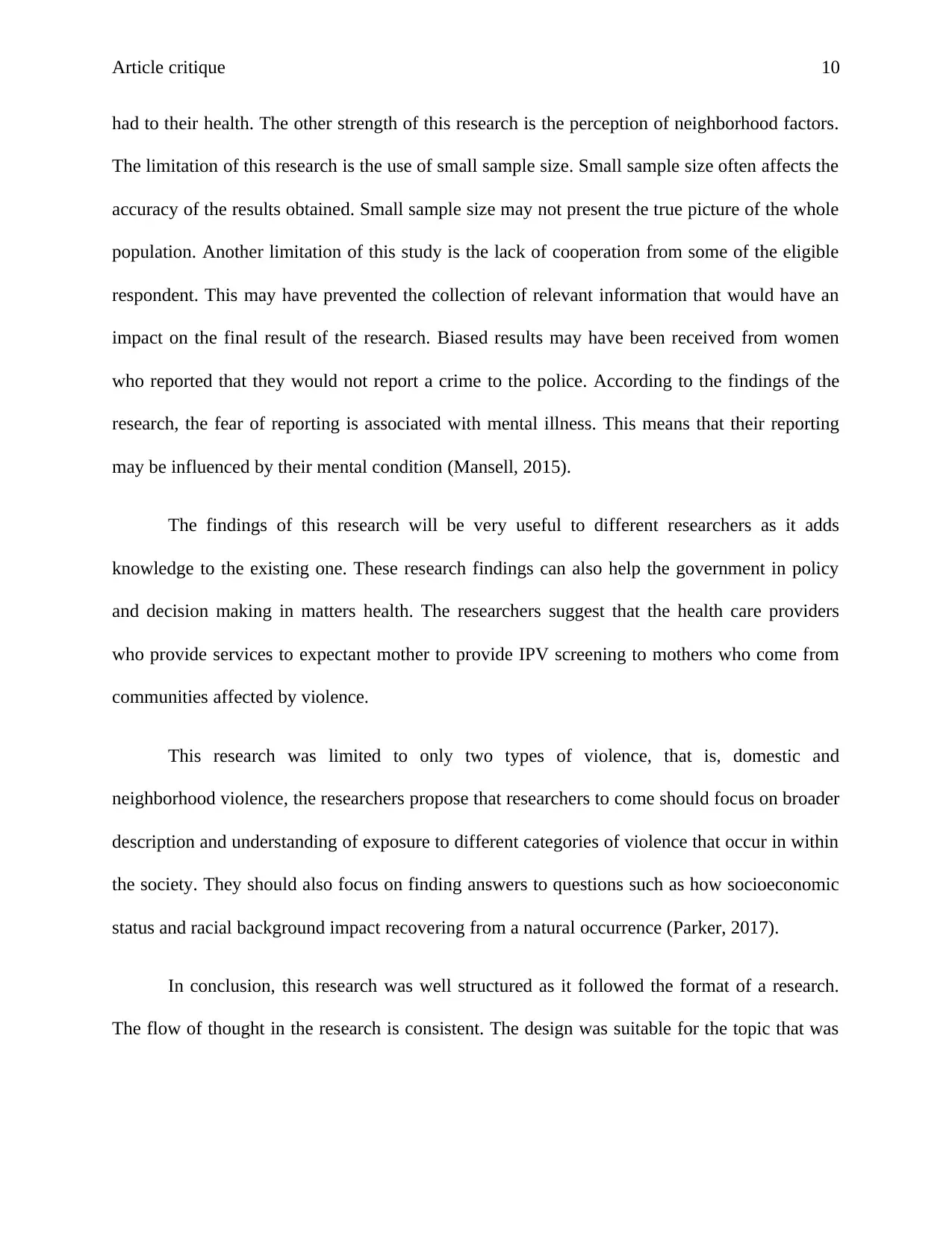
Article critique 10
had to their health. The other strength of this research is the perception of neighborhood factors.
The limitation of this research is the use of small sample size. Small sample size often affects the
accuracy of the results obtained. Small sample size may not present the true picture of the whole
population. Another limitation of this study is the lack of cooperation from some of the eligible
respondent. This may have prevented the collection of relevant information that would have an
impact on the final result of the research. Biased results may have been received from women
who reported that they would not report a crime to the police. According to the findings of the
research, the fear of reporting is associated with mental illness. This means that their reporting
may be influenced by their mental condition (Mansell, 2015).
The findings of this research will be very useful to different researchers as it adds
knowledge to the existing one. These research findings can also help the government in policy
and decision making in matters health. The researchers suggest that the health care providers
who provide services to expectant mother to provide IPV screening to mothers who come from
communities affected by violence.
This research was limited to only two types of violence, that is, domestic and
neighborhood violence, the researchers propose that researchers to come should focus on broader
description and understanding of exposure to different categories of violence that occur in within
the society. They should also focus on finding answers to questions such as how socioeconomic
status and racial background impact recovering from a natural occurrence (Parker, 2017).
In conclusion, this research was well structured as it followed the format of a research.
The flow of thought in the research is consistent. The design was suitable for the topic that was
had to their health. The other strength of this research is the perception of neighborhood factors.
The limitation of this research is the use of small sample size. Small sample size often affects the
accuracy of the results obtained. Small sample size may not present the true picture of the whole
population. Another limitation of this study is the lack of cooperation from some of the eligible
respondent. This may have prevented the collection of relevant information that would have an
impact on the final result of the research. Biased results may have been received from women
who reported that they would not report a crime to the police. According to the findings of the
research, the fear of reporting is associated with mental illness. This means that their reporting
may be influenced by their mental condition (Mansell, 2015).
The findings of this research will be very useful to different researchers as it adds
knowledge to the existing one. These research findings can also help the government in policy
and decision making in matters health. The researchers suggest that the health care providers
who provide services to expectant mother to provide IPV screening to mothers who come from
communities affected by violence.
This research was limited to only two types of violence, that is, domestic and
neighborhood violence, the researchers propose that researchers to come should focus on broader
description and understanding of exposure to different categories of violence that occur in within
the society. They should also focus on finding answers to questions such as how socioeconomic
status and racial background impact recovering from a natural occurrence (Parker, 2017).
In conclusion, this research was well structured as it followed the format of a research.
The flow of thought in the research is consistent. The design was suitable for the topic that was
Paraphrase This Document
Need a fresh take? Get an instant paraphrase of this document with our AI Paraphraser
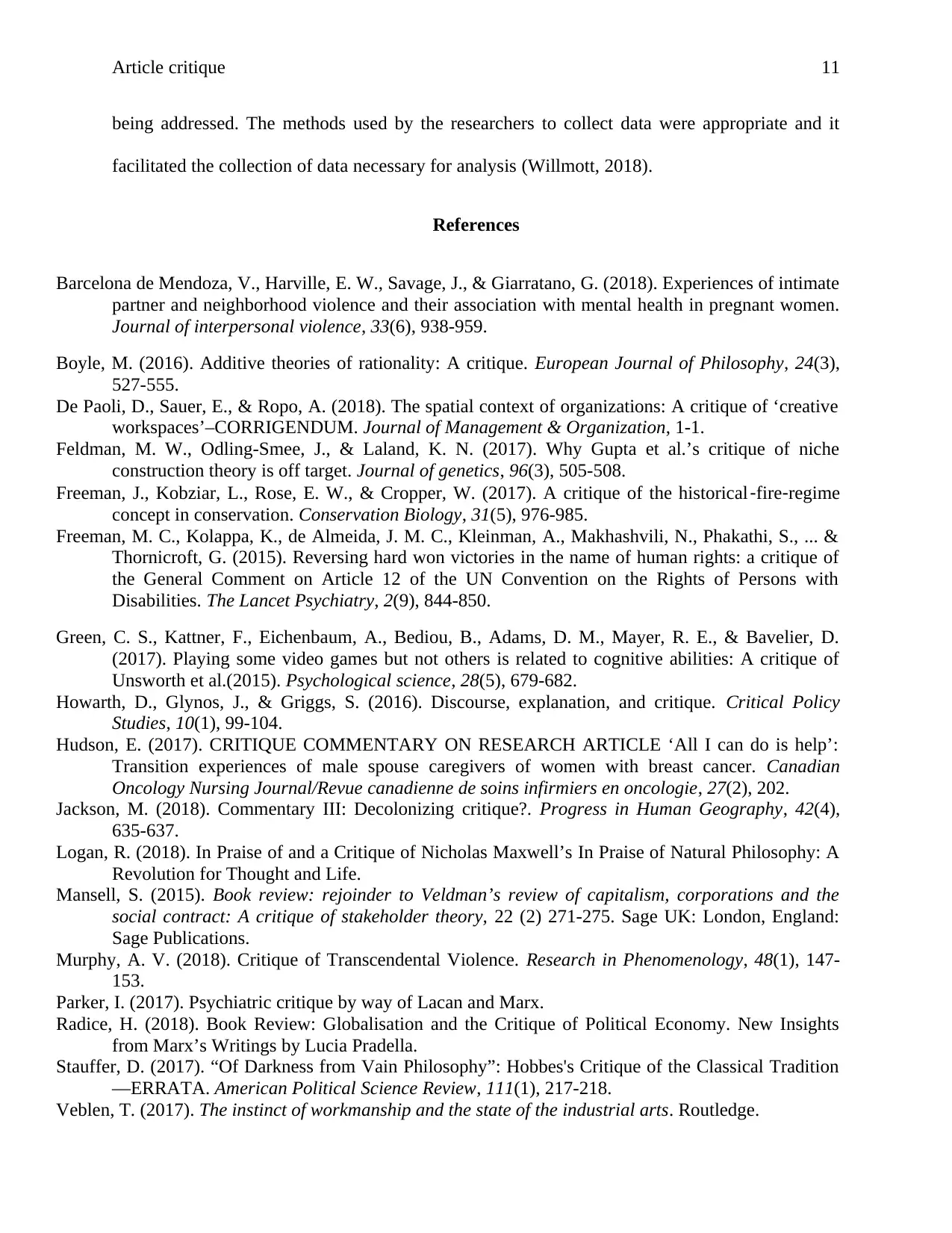
Article critique 11
being addressed. The methods used by the researchers to collect data were appropriate and it
facilitated the collection of data necessary for analysis (Willmott, 2018).
References
Barcelona de Mendoza, V., Harville, E. W., Savage, J., & Giarratano, G. (2018). Experiences of intimate
partner and neighborhood violence and their association with mental health in pregnant women.
Journal of interpersonal violence, 33(6), 938-959.
Boyle, M. (2016). Additive theories of rationality: A critique. European Journal of Philosophy, 24(3),
527-555.
De Paoli, D., Sauer, E., & Ropo, A. (2018). The spatial context of organizations: A critique of ‘creative
workspaces’–CORRIGENDUM. Journal of Management & Organization, 1-1.
Feldman, M. W., Odling-Smee, J., & Laland, K. N. (2017). Why Gupta et al.’s critique of niche
construction theory is off target. Journal of genetics, 96(3), 505-508.
Freeman, J., Kobziar, L., Rose, E. W., & Cropper, W. (2017). A critique of the historical ‐fire‐regime
concept in conservation. Conservation Biology, 31(5), 976-985.
Freeman, M. C., Kolappa, K., de Almeida, J. M. C., Kleinman, A., Makhashvili, N., Phakathi, S., ... &
Thornicroft, G. (2015). Reversing hard won victories in the name of human rights: a critique of
the General Comment on Article 12 of the UN Convention on the Rights of Persons with
Disabilities. The Lancet Psychiatry, 2(9), 844-850.
Green, C. S., Kattner, F., Eichenbaum, A., Bediou, B., Adams, D. M., Mayer, R. E., & Bavelier, D.
(2017). Playing some video games but not others is related to cognitive abilities: A critique of
Unsworth et al.(2015). Psychological science, 28(5), 679-682.
Howarth, D., Glynos, J., & Griggs, S. (2016). Discourse, explanation, and critique. Critical Policy
Studies, 10(1), 99-104.
Hudson, E. (2017). CRITIQUE COMMENTARY ON RESEARCH ARTICLE ‘All I can do is help’:
Transition experiences of male spouse caregivers of women with breast cancer. Canadian
Oncology Nursing Journal/Revue canadienne de soins infirmiers en oncologie, 27(2), 202.
Jackson, M. (2018). Commentary III: Decolonizing critique?. Progress in Human Geography, 42(4),
635-637.
Logan, R. (2018). In Praise of and a Critique of Nicholas Maxwell’s In Praise of Natural Philosophy: A
Revolution for Thought and Life.
Mansell, S. (2015). Book review: rejoinder to Veldman’s review of capitalism, corporations and the
social contract: A critique of stakeholder theory, 22 (2) 271-275. Sage UK: London, England:
Sage Publications.
Murphy, A. V. (2018). Critique of Transcendental Violence. Research in Phenomenology, 48(1), 147-
153.
Parker, I. (2017). Psychiatric critique by way of Lacan and Marx.
Radice, H. (2018). Book Review: Globalisation and the Critique of Political Economy. New Insights
from Marx’s Writings by Lucia Pradella.
Stauffer, D. (2017). “Of Darkness from Vain Philosophy”: Hobbes's Critique of the Classical Tradition
—ERRATA. American Political Science Review, 111(1), 217-218.
Veblen, T. (2017). The instinct of workmanship and the state of the industrial arts. Routledge.
being addressed. The methods used by the researchers to collect data were appropriate and it
facilitated the collection of data necessary for analysis (Willmott, 2018).
References
Barcelona de Mendoza, V., Harville, E. W., Savage, J., & Giarratano, G. (2018). Experiences of intimate
partner and neighborhood violence and their association with mental health in pregnant women.
Journal of interpersonal violence, 33(6), 938-959.
Boyle, M. (2016). Additive theories of rationality: A critique. European Journal of Philosophy, 24(3),
527-555.
De Paoli, D., Sauer, E., & Ropo, A. (2018). The spatial context of organizations: A critique of ‘creative
workspaces’–CORRIGENDUM. Journal of Management & Organization, 1-1.
Feldman, M. W., Odling-Smee, J., & Laland, K. N. (2017). Why Gupta et al.’s critique of niche
construction theory is off target. Journal of genetics, 96(3), 505-508.
Freeman, J., Kobziar, L., Rose, E. W., & Cropper, W. (2017). A critique of the historical ‐fire‐regime
concept in conservation. Conservation Biology, 31(5), 976-985.
Freeman, M. C., Kolappa, K., de Almeida, J. M. C., Kleinman, A., Makhashvili, N., Phakathi, S., ... &
Thornicroft, G. (2015). Reversing hard won victories in the name of human rights: a critique of
the General Comment on Article 12 of the UN Convention on the Rights of Persons with
Disabilities. The Lancet Psychiatry, 2(9), 844-850.
Green, C. S., Kattner, F., Eichenbaum, A., Bediou, B., Adams, D. M., Mayer, R. E., & Bavelier, D.
(2017). Playing some video games but not others is related to cognitive abilities: A critique of
Unsworth et al.(2015). Psychological science, 28(5), 679-682.
Howarth, D., Glynos, J., & Griggs, S. (2016). Discourse, explanation, and critique. Critical Policy
Studies, 10(1), 99-104.
Hudson, E. (2017). CRITIQUE COMMENTARY ON RESEARCH ARTICLE ‘All I can do is help’:
Transition experiences of male spouse caregivers of women with breast cancer. Canadian
Oncology Nursing Journal/Revue canadienne de soins infirmiers en oncologie, 27(2), 202.
Jackson, M. (2018). Commentary III: Decolonizing critique?. Progress in Human Geography, 42(4),
635-637.
Logan, R. (2018). In Praise of and a Critique of Nicholas Maxwell’s In Praise of Natural Philosophy: A
Revolution for Thought and Life.
Mansell, S. (2015). Book review: rejoinder to Veldman’s review of capitalism, corporations and the
social contract: A critique of stakeholder theory, 22 (2) 271-275. Sage UK: London, England:
Sage Publications.
Murphy, A. V. (2018). Critique of Transcendental Violence. Research in Phenomenology, 48(1), 147-
153.
Parker, I. (2017). Psychiatric critique by way of Lacan and Marx.
Radice, H. (2018). Book Review: Globalisation and the Critique of Political Economy. New Insights
from Marx’s Writings by Lucia Pradella.
Stauffer, D. (2017). “Of Darkness from Vain Philosophy”: Hobbes's Critique of the Classical Tradition
—ERRATA. American Political Science Review, 111(1), 217-218.
Veblen, T. (2017). The instinct of workmanship and the state of the industrial arts. Routledge.

Article critique 12
Weltje, L., & Sumpter, J. P. (2017). What makes a concentration environmentally relevant? Critique and
a Proposal.
Williams, G. C. (2018). Adaptation and natural selection: A critique of some current evolutionary
thought, 61. Princeton university press.
Willmott, H. (2018). Can It? On Expanding Institutional Theory by Disarming Critique. Journal of
Management Inquiry, 1056492617744893.
Weltje, L., & Sumpter, J. P. (2017). What makes a concentration environmentally relevant? Critique and
a Proposal.
Williams, G. C. (2018). Adaptation and natural selection: A critique of some current evolutionary
thought, 61. Princeton university press.
Willmott, H. (2018). Can It? On Expanding Institutional Theory by Disarming Critique. Journal of
Management Inquiry, 1056492617744893.
⊘ This is a preview!⊘
Do you want full access?
Subscribe today to unlock all pages.

Trusted by 1+ million students worldwide
1 out of 12
Your All-in-One AI-Powered Toolkit for Academic Success.
+13062052269
info@desklib.com
Available 24*7 on WhatsApp / Email
![[object Object]](/_next/static/media/star-bottom.7253800d.svg)
Unlock your academic potential
Copyright © 2020–2025 A2Z Services. All Rights Reserved. Developed and managed by ZUCOL.